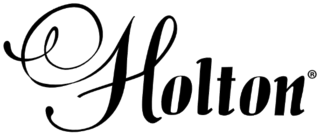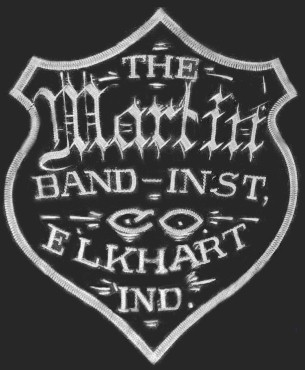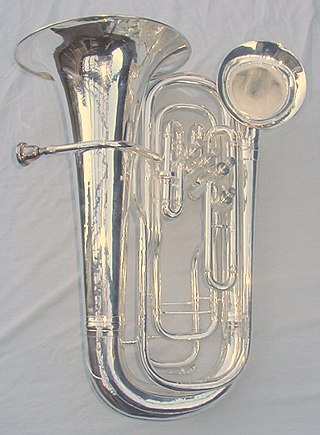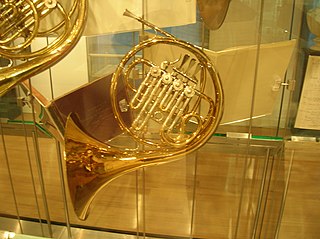
The euphonium is a medium-sized, 3- or 4-valve, often compensating, conical-bore, tenor-voiced brass instrument that derives its name from the Ancient Greek word εὔφωνος euphōnos, meaning "well-sounding" or "sweet-voiced". The euphonium is a valved instrument. Nearly all current models have piston valves, though some models with rotary valves do exist.

The French horn is a brass instrument made of tubing wrapped into a coil with a flared bell. The double horn in F/B♭ is the horn most often used by players in professional orchestras and bands, although the descant and triple horn have become increasingly popular. A musician who plays a horn is known as a horn player or hornist.

The trombone is a musical instrument in the brass family. As with all brass instruments, sound is produced when the player's vibrating lips cause the air column inside the instrument to vibrate. Nearly all trombones use a telescoping slide mechanism to alter the pitch instead of the valves used by other brass instruments. The valve trombone is an exception, using three valves similar to those on a trumpet, and the superbone has valves and a slide.

Eisenach is a town in Thuringia, Germany with 42,000 inhabitants, located 50 kilometres west of Erfurt, 70 km southeast of Kassel and 150 km northeast of Frankfurt. It is the main urban centre of western Thuringia and bordering northeastern Hessian regions, situated near the former Inner German border. A major attraction is Wartburg castle, which has been a UNESCO World Heritage Site since 1999.

The mellophone is a brass instrument used in marching bands and drum and bugle corps in place of French horns. It is a middle-voiced instrument, typically pitched in the key of F, though models in E♭, D, C, and G have also historically existed. It has a conical bore, like that of the euphonium and flugelhorn. It can also be used to play French horn parts in concert bands and orchestras.

The valve trombone is a brass instrument in the trombone family that has a set of valves to vary the pitch instead of a slide. Although it has been built in sizes from alto to contrabass, it is the tenor valve trombone pitched in B♭ an octave lower than the trumpet which has seen the most widespread use. The most common models have three piston valves. They are found in jazz and popular music, as well as marching bands in Europe, where they are often built with rotary valves and were widely used in orchestras in the 19th century.

The superbone is a hybrid tenor trombone in B♭ that has both a slide like a regular trombone and a set of valves like a valve trombone.
C. G. Conn Ltd., Conn Instruments or commonly just Conn, is a former American manufacturer of musical instruments incorporated in 1915. It bought the production facilities owned by Charles Gerard Conn, a major figure in early manufacture of brasswinds and saxophones in the USA. Its early business was based primarily on brass instruments, which were manufactured in Elkhart, Indiana. During the 1950s the bulk of its sales revenue shifted to electric organs. In 1969 the company was sold in bankruptcy to the Crowell-Collier-MacMillan publishing company. Conn was divested of its Elkhart production facilities in 1970, leaving remaining production in satellite facilities and contractor sources.

The Vincent Bach Corporation is a US manufacturer of brass instruments that began early in the early Twentieth Century and still exists as a subsidiary of Conn-Selmer, a division of Steinway Musical Instruments. The company was founded in 1918 by Austrian-born trumpeter Vinzenz Schrottenbach.
Conn-Selmer, Inc. is an American manufacturer of musical instruments for concert bands, marching bands and orchestras. It is a wholly owned subsidiary of Steinway Musical Instruments and was formed in 2003 by combining the Steinway properties, The Selmer Company and United Musical Instruments.

The axial flow valve, or Thayer valve, is a brass instrument valve design patented in 1978 by Orla Ed Thayer. Designed with assistance from Zigmant Kanstul, it was originally intended to replace the traditional rotary valve on the French horn, but instead revolutionized the design of trombone valve attachments. Combined with open-wrap tubing, it eliminates the impedance caused by tight tubing bends, improving the airflow through the instrument and the open "feel" perceived by the player.

The bass trombone is the bass instrument in the trombone family of brass instruments. Modern instruments are pitched in the same B♭ as the tenor trombone but with a larger bore, bell and mouthpiece to facilitate low register playing, and usually two valves to fill in the missing range immediately above the pedal tones.

Buffet Crampon SAS is a French manufacturer of wind instruments based in Mantes-la-Ville, Yvelines department. The company is the world market leader in the production of clarinets of the Boehm system. Its subsidiary, Buffet Crampon Deutschland GmbH, founded in 2010 and based in Markneukirchen, Vogtland, Sachsen, is the world market leader in the manufacture of brass instruments. To manufacture and sell its products, the BC Group employed around 1000 people worldwide at the beginning of 2021, 470 of them as employees of BC Germany alone. The management of the group has been in the hands of Jérôme Perrod since 2014.

Holton is a brand owned by the Conn-Selmer division of Steinway Musical Instruments. The original business was a used instrument shop began in 1898 by American trombone player Frank Holton in Chicago, Illinois. The firm built brass instruments for ten years in Chicago, then in Elkhorn, Wisconsin from 1918 until 2008, when production of Holton-branded instruments moved to Eastlake, Ohio. The business remained independent until it was acquired by Leblanc in 1964. Leblanc was acquired by Conn-Selmer in 2004 and its properties became subsidiaries of Conn-Selmer.

The Martin Band Instrument Company was a musical instrument manufacturer in Elkhart, Indiana. The firm produced band instruments, including trumpets, cornets, fluegelhorns, trombones, and saxophones from 1908 through the 1960s. The brand was acquired by the Leblanc Corporation in 1971 and discontinued in 2007 after Leblanc's 2004 acquisition by Conn-Selmer.

The double bell euphonium is a duplex instrument based on the euphonium. The larger bell produces the mellow tone of a standard euphonium; the second smaller bell has a brighter tone, similar to a baritone horn or valve trombone. The instrument is sometimes dismissed as a novelty, but has had some enthusiastic adherents, including few professional musicians using it as their sole or primary instrument. The smaller bell can give more appropriate tone in the higher range of the instrument. The two bells can also be used for special effects, such as echoes, and using the distinctly different tone of the two bells for a single musician to give the effect of call and response.

The contrabass trombone is the lowest-pitched instrument in the trombone family of brass instruments. While modern instruments are pitched in 12 ft F with a single slide, the first practical contrabass trombones appeared in the mid-19th century built in 18′ B♭ an octave below the tenor trombone with a double slide. German opera composer Richard Wagner notably called for this instrument in his Der Ring des Nibelungen opera cycle in the 1870s, and contrabass trombone has since appeared occasionally in large orchestral works without becoming a permanent member of the modern orchestra.

King Musical Instruments is a former musical instrument manufacturing company located in Cleveland, Ohio, that used the trade name King for its instruments. In 1965 the company was acquired by the Seeburg Corporation of Eastlake, Ohio, and the name changed to "King Musical Instruments".

The German horn is a brass instrument made of tubing wrapped into a coil with a flared bell, and in bands and orchestras is the most widely used of three types of horn, the other two being the French horn and the Vienna horn. Its use among professional players has become so universal that it is only in France and Vienna that any other kind of horn is used today. A musician who plays the German horn is called a horn player. The word "German" is used only to distinguish this instrument from the now-rare French and Viennese instruments. Although the expression "French horn" is still used colloquially in English for any orchestral horn, since the 1930s professional musicians and scholars have generally avoided this term in favour of just "horn". Vienna horns today are played only in Vienna, and are made only by Austrian firms. German horns, by contrast, are not all made by German manufacturers, nor are all French-style instruments made in France.

















